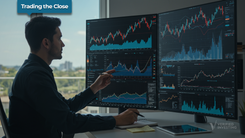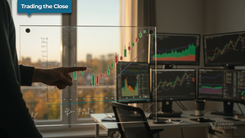My Trading Game Plan Revealed - 11/03/2025: Crocodile Jaws Divergence Warns of AI-Led Market Top

In this morning's My Trading Game Plan, Gareth Soloway, Chief Market Strategist at Verified Investing, cut through the market noise to reveal a series of powerful, data-driven signals that every trader needs to understand. Following a pivotal week that included a Federal Reserve announcement, a high-stakes meeting between Trump and Xi, and a flurry of mega-cap earnings, the market is sending mixed messages. While indices hover near all-time highs, a look beneath the surface reveals a growing chasm between the market's leaders and laggards—a divergence so extreme it's creating what Gareth calls "crocodile jaws."
Today, we'll expand on the critical themes from the show, exploring the institutional selling hidden in plain sight, the ominous signal from Warren Buffett's massive cash pile, and a mind-blowing technical pattern in semiconductors that has preceded collapses of 40% or more—twice.
The Institutional Footprint: Decoding Morning Weakness
On Friday, the market painted a picture of a flat, uneventful day. However, the intraday action told a more nuanced story. A sharp sell-off in the morning was followed by a gradual float higher into the close. To the untrained eye, this looks like a resilient market shaking off early weakness. To a professional, it’s a potential red flag signaling institutional distribution.
As Gareth explained, the timing of buying and selling pressure is critical. “When you see selling in the first half of the day, it's generally driven by institutions. The reason this is the case is because they are going to be the ones unloading when there's the most volume in the market… in general, when you see big selling early and then the markets float back up, that's because the institutions are dumping.”
Large institutions managing billions of dollars can't simply click a button to sell their massive positions. They require significant liquidity—a high volume of buyers—to exit without drastically moving the price against them. The morning session, with its high volume and participation, provides the perfect cover. Once they've "shut off the sell valve," the lower-volume afternoon session is often dominated by retail traders, who see the dip as a buying opportunity and help the market drift back up. This dynamic creates an illusion of strength while large players may be quietly heading for the exits.
The Great Divergence: Unpacking the "Crocodile Jaws"
The most significant warning sign in today's market isn't a single chart pattern but a massive and growing divergence between the handful of stocks driving the market and everything else. This is best illustrated by comparing the market-cap-weighted S&P 500 with the equal-weight S&P 500 (RSP). The former is dominated by giants like NVIDIA, which recently hit a $5 trillion market cap, while the latter provides a true health check on the average S&P company.
The gap between these two indices has widened to historic levels, creating a pattern Gareth refers to as "crocodile jaws." The data is stunning:
- 75% of the S&P 500's gains over the last two years have come from AI-related stocks.
- 90% of U.S. GDP growth is attributable to the AI trade and associated capital expenditures.
This means the rest of the economy is essentially stagnant. We see this reflected in the stock performance of companies that represent the average American consumer. Names like Chipotle, Kava, McDonald's, and Procter & Gamble are trading at or near multi-year lows. Meanwhile, NVIDIA and other AI darlings are at all-time highs. The "crocodile jaws" have opened wider than they did at the 2021 market top, suggesting an unsustainable imbalance.
Eventually, these jaws snap shut. This doesn't necessarily mean the equal-weight index will surge, but it strongly implies a period of significant underperformance for the mega-cap leaders. Capital will rotate, and the market-cap-weighted index is likely to fall much more sharply to close the gap. For investors, this signals a time for caution in chasing the high-flyers and a potential opportunity in defensive, value-oriented names that have been left behind.
The Oracle’s Ominous Signal: Buffett’s $385 Billion Bet
If the market's internal divergence isn't convincing enough, look no further than the actions of the world's most revered long-term investor. This past weekend, it was revealed that Warren Buffett's Berkshire Hathaway has increased its cash position to an astounding $385 billion USD. This isn't a fund manager making a short-term tactical move; this is the "Oracle of Omaha" systematically selling stocks and building a war chest.
This action echoes Buffett's strategy during previous market crises. In the depths of the 2008-2009 financial crisis, when Goldman Sachs was on the brink of collapse, Buffett stepped in with his cash reserves and secured one of the most lucrative deals in financial history. He provided the capital that Goldman desperately needed and, in return, received terms that were massively favorable to Berkshire.
Gareth sees history repeating itself. “I'm telling you right now, Warren Buffett is waiting. He knows this is coming and he is waiting for that next situation to deploy three hundred eighty five billion dollars and he will make a fortune again, just like with that Goldman Sachs investment.”
Buffett's strategy is a powerful lesson in patience and value. He doesn't chase momentum; he waits for panic and dislocation to deploy his capital at bargain prices. His decision to hold a record amount of cash is a clear vote of no-confidence in current market valuations. It's a signal that he believes better opportunities—born from a significant market correction—are on the horizon.
A Mind-Blowing Signal: Are Semiconductors Topping Out?
While market internals and investor sentiment provide crucial context, the most stunning piece of evidence for a potential market top comes from a single, powerful technical chart: the weekly chart of the VanEck Semiconductor ETF (SMH). The AI trade, which has single-handedly propped up the market, is showing a pattern that is almost too perfect to believe.
Gareth uses the 200-week moving average as a "home base" for price—a center of gravity that price eventually returns to, much like a stretched rubber band snapping back. His analysis revealed a remarkable historical pattern in the SMH:
- The 2021 Top: The SMH rallied until it was exactly 102% above its 200-week moving average. It then collapsed by 45%.
- The 2024 Top: The SMH rallied again until it was exactly 102% above its 200-week moving average. It then collapsed by 40%.
- Last Week: The SMH hit a new all-time high, peaking at exactly 102% above its 200-week moving average.
The precision is breathtaking. Three distinct market tops, all defined by the exact same percentage extension from their long-term mean. “Probability and logic, which is what Verified Investing is all about. What does this tell us?” Gareth asked. “The odds are starting to favor a big pullback, not just a small pullback, but like we pulled back forty five percent in twenty twenty one and forty percent in twenty twenty four.”
This is not a guarantee, but it is an incredibly high-probability signal. When the engine of the entire bull market—the semiconductor sector—reaches a point of extension that has historically marked the exact top before major corrections, traders must pay attention.
Navigating Key Levels in Palantir, Commodities, and Crypto
Beyond the macro picture, specific assets are approaching critical inflection points.
- Palantir (PLTR): Reporting earnings after the bell, Palantir is a battleground stock with a sky-high valuation, trading at multiples of revenue, not earnings. The chart shows a potential max upside move to the $220 level on a blowout report. However, given its valuation, any sign of slowing growth—a "crack in the narrative"—could trigger massive downside in the coming months.
- Gold and Silver: Gold is consolidating just above a key support level, while Silver offers a cautionary tale. Silver topped out perfectly at the high end of its parallel channel before correcting sharply. The S&P 500 is now testing the top of a nearly identical parallel channel, reinforcing the potential for a similar pullback.
- Oil: Crude oil is carving out a potential inverse head and shoulders pattern, a bullish formation. However, the pattern is not yet confirmed. A breakout and close above the neckline at $62.40 USD is required to trigger the trade, with a potential target near $68-$70 USD. This is a classic lesson in waiting for confirmation before acting.
- Bitcoin and Ethereum: Bitcoin failed to confirm a breakout above a key trendline, a classic institutional "fakeout" move. The path of least resistance now appears lower, with initial support near $98,000 USD and a larger target zone of $93,000 to $95,000 USD. Meanwhile, Ethereum is in a more precarious position, trading below a major multi-year up-trending support line. A confirmed close below this level would signal a probable move down towards the $2,750-$2,800 USD area.
Conclusion: Trade with Logic, Not Hope
The market is at a fascinating and potentially treacherous juncture. While the major indices appear calm on the surface, the underlying currents tell a story of extreme divergence, institutional selling, and historical topping signals. The "Crocodile Jaws" between the AI leaders and the rest of the market are wider than ever, Warren Buffett is hoarding cash in anticipation of a downturn, and the semiconductor sector is flashing a 102% extension signal that has twice preceded major market collapses.
In this environment, emotion is the enemy. Hope is not a strategy. Success comes from a disciplined, logical, and probability-based approach. As Gareth powerfully stated, “Probability is my fastest way of how I got to be a multimillionaire. And I want you guys to start thinking that way. Think logically right up here. If you think logically, you will make decisions based on probability, which means success and profits in any type of market, not just bull markets.”
The data is clear. The warning signs are present. By respecting the technical levels, understanding the macro context, and trading based on probabilities, not predictions, you can navigate what comes next with clarity and confidence.
Trading involves substantial risk. All content is for educational purposes only and should not be considered financial advice or recommendations to buy or sell any asset. Read full terms of service.




